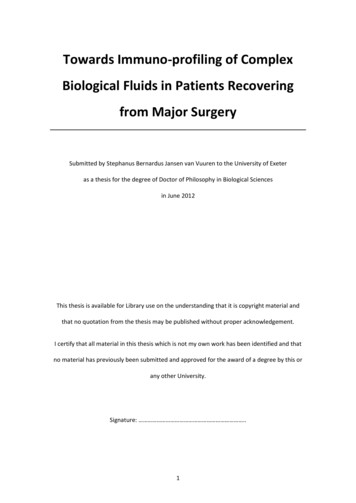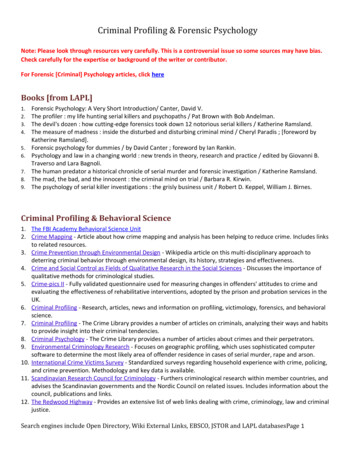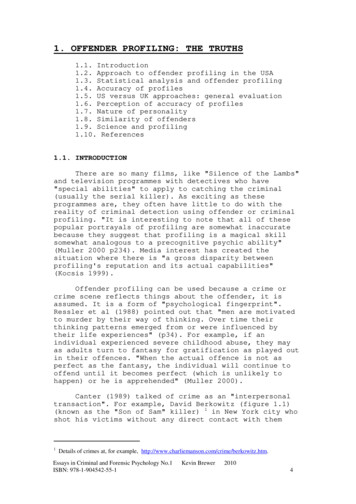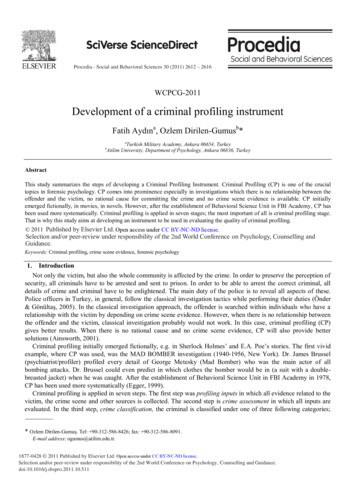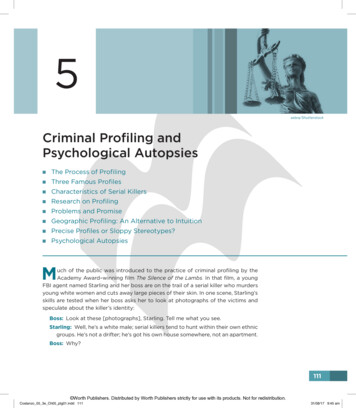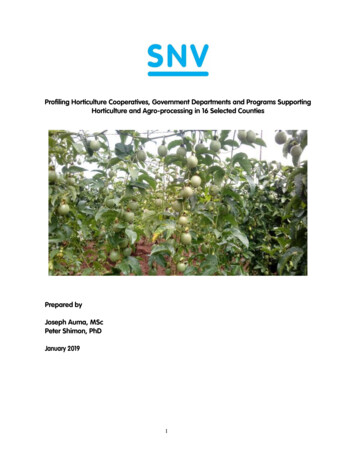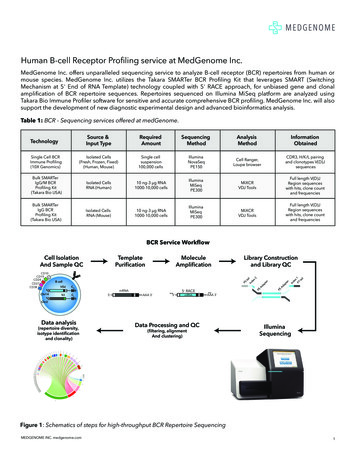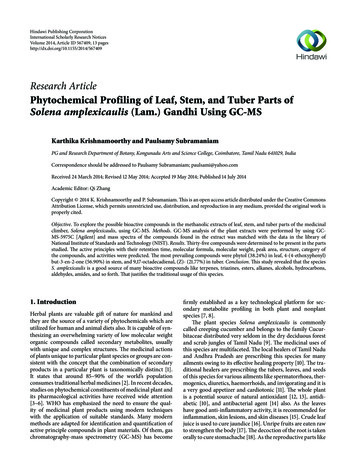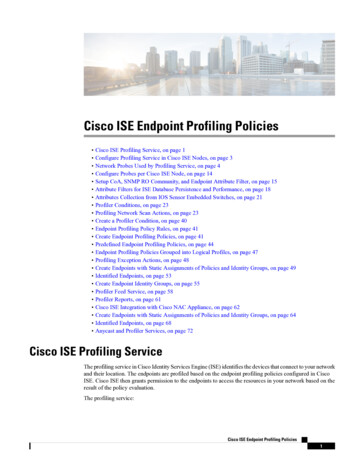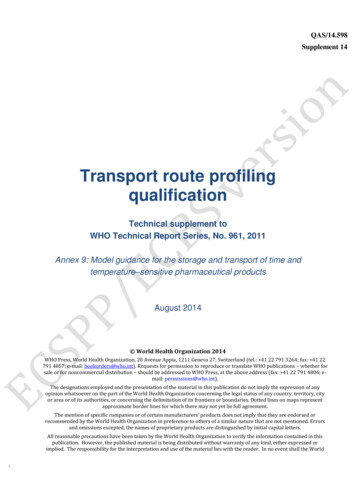
Transcription
QAS/14.598Supplement 14WHO VaccineTransport route profilingqualificationTechnical supplement toWHO Technical Report Series, No. 961, 2011Annex 9: Model guidance for the storage and transport of time andtemperature–sensitive pharmaceutical productsAugust 2014 World Health Organization 2014WHO Press, World Health Organization, 20 Avenue Appia, 1211 Geneva 27, Switzerland (tel.: 41 22 791 3264; fax: 41 22791 4857; e-mail: bookorders@who.int). Requests for permission to reproduce or translate WHO publications – whether forsale or for noncommercial distribution – should be addressed to WHO Press, at the above address (fax: 41 22 791 4806; email: permissions@who.int).The designations employed and the presentation of the material in this publication do not imply the expression of anyopinion whatsoever on the part of the World Health Organization concerning the legal status of any country, territory, cityor area or of its authorities, or concerning the delimitation of its frontiers or boundaries. Dotted lines on maps representapproximate border lines for which there may not yet be full agreement.The mention of specific companies or of certain manufacturers’ products does not imply that they are endorsed orrecommended by the World Health Organization in preference to others of a similar nature that are not mentioned. Errorsand omissions excepted, the names of proprietary products are distinguished by initial capital letters.All reasonable precautions have been taken by the World Health Organization to verify the information contained in thispublication. However, the published material is being distributed without warranty of any kind, either expressed orimplied. The responsibility for the interpretation and use of the material lies with the reader. In no event shall the World
Health Organization be liable for damages arising from its use. The named authors alone are responsible for the viewsexpressed in this publication.
AcknowledgmentsThe authors of this document are Kevin O’Donnell, Exelsius Cold Chain ManagementConsultancy and member of the United States Pharmacopeia Expert Committee onPackaging, Storage & Distribution 2010-2015 cycle, Susan Li, United Parcel Service, MarkMaurice, Sensitech, and Ken Maltas, Sally Eggers, Sonoco ThermoSafe and Andrew Garnett,WHO consultant.Technical Supplement: Transport route profiling qualification3
ContentsAcknowledgments . 3Contents . 4Abbreviations . 5Glossary . 61.Introduction . 91.1 Requirements . 101.2 Objectives. 101.3 Target readership . 102.Guidance .112.1 Associated materials and equipment . 122.2 Study protocol. 122.3 Carrying out the study . 132.4 Data retrieval. 142.5 Understanding temperature exposure: the degree-hour concept . 152.6 Organizing, analysing and using the data . 162.6.1Method A for designing and testing packaging solutions . 172.6.2Method B for passive containers with known performance characteristics . 19References .22Annex 1 – Method B examples .23A1.1 Using the data . 23A1.2.The warm climate case. 23A1.2.1Step 1: organize and analyse the route profile data. 24A1.2.2Step 2: assess container suitability . 25A1.3The cold climate case . 25A1.3.1Step 1: organize and analyse the route profile data. 25A1.3.2Step 2: assess container suitability . 26Revision history .27Technical Supplement: Transport route profiling qualification4
AbbreviationsCCPCritical Control PointEDLMElectronic Data Logging MonitorISTAInternational Safe Transit AssociationPDAParenteral Drug AssociationTTSPPTime and Temperature-Sensitive Pharmaceutical ProductTechnical Supplement: Transport route profiling qualification5
GlossaryAmbient temperature: The uncontrolled prevailing temperature(s) within a specificenvironment or series of environments, such as a supply chain.Conditioned ice-pack: An ice-pack that has been allowed to warm at ambienttemperature until some liquid water is present inside the pack. The pack is correctlyconditioned as soon as the ice core is able to move inside the pack when it is shaken. Theeffective temperature of a conditioned ice-pack in this state is 0.0 C1.Cool life (test): The empty passive container is stabilized at 43.0 C and loaded with coolwater-packs which have been stabilized at 5.0 C for a minimum of 24 hours. Cool life ismeasured from the moment when the container is closed, until the temperature of thewarmest point inside the storage compartment first reaches 20.0 C, at a constantambient temperature of 43.0 C2.Cool water-pack: A water-pack cooled to a temperature of 5.0 C before use3.Critical Control Point (CCP): A step or procedure at which controls or checks can beapplied to prevent or reduce a hazard or risk to and acceptable or critical level. In thecontext of distribution and handling of time and temperature-sensitive healthcareproducts, critical control points are typically defined for those activities where time andtemperature abuse may occur or where critical processes that can affect the performanceof the packaging solution or containment system are at risk.Design qualification: The process of obtaining and documenting evidence that thepremises, equipment and supporting systems and processes have been designed inaccordance with the requirements for Good Manufacturing Practices (GMP)4.Electronic Data Logging Monitor (EDLM): A small portable device that measures andstores temperature at a pre-determined time intervals by means of an electronic sensor.They have programmable alarm capabilities, integrated displays, and can create reportsand graphs which may be permanently stored, shared and analysed via proprietaryhardware, software, desktop application or through hosted databases.External distribution: Transport of TTSPPs through various steps in the customer’ssupply chain (i.e. transport from a pharmaceutical manufacturer’s distribution centre, tocommercial customers (including wholesalers, retailers and buying groups), to clinicalfacilities or direct to the patient). Contrast with internal distribution.Ice-pack: A water-pack that has been frozen to a temperature between -5.0 C and -25.0 Cbefore use5.Internal distribution: Transport of a TTSPP within a pharmaceutical manufacturer’sinternal supply chain (i.e. all internal transport from the manufacturing plant to theSource: WHO PQSSource: ibid3 Source: ibid4 WHO Technical Report Series, No. 961, 2011. Annex 3: WHO good manufacturing practices forpharmaceutical products: main principles.5 Source: WHO PQS12Technical Supplement: Transport route profiling qualification6
packaging plant and onwards to warehouses and distribution centres). Contrast withexternal distribution.Lanes: Transport routes from a point of origin to a destination.Operational qualification (OQ): The process of obtaining and documenting evidence,under controlled conditions, that the premises, equipment and supporting systemsoperate in accordance with their design specifications.Passive systems: Systems which maintain a temperature-controlled environment insidean insulated enclosure, with or without thermostatic regulation, using a finite amount ofpre-conditioned coolant in the form of chilled or frozen gel packs, phase change materials,dry ice or others.Pharmaceutical product: Any product intended for human use or veterinary productintended for administration to food producing animals, presented in its finished dosageform, that is subject to control by pharmaceutical legislation in either the exporting or theimporting state and includes products for which a prescription is required, productswhich may be sold to patients without a prescription, biologicals and vaccines. Medicaldevices are not included6.Qualification protocol: A written and approved plan detailing how a qualification will beconducted including test parameters, product characteristics, equipment and acceptancecriteria.Qualification: Action of proving that any premises, equipment and supporting systemswork correctly and actually lead to the expected results. The meaning of the wordvalidation is sometimes extended to incorporate the concept of qualification.Shipping system: All components constituting a completed package including: the outershipping container, all internal ancillary packaging components and temperaturestabilizing medium.Standard Operating Procedure (SOP): A set of instructions having the force of adirective, covering those features of operations that lend themselves to a definite orstandardized procedure without loss of effectiveness. Standard operating policies andprocedures can be effective catalysts to drive performance improvement and improveorganizational results.Study protocol: A document detailing the scope, objectives and operational specifics of aseries of tests or data collection (study) written and approved in advance of execution ofthe study.Temperature excursion: An excursion event in which a TTSPP is exposed totemperatures outside the range(s) prescribed for storage and/or transport. Temperatureranges for storage and transport may be the same or different; they are determined by theproduct manufacturer, based on stability data.Temperature-controlled: Includes any environment in which the temperature is activelyor passively controlled at a level different from that of the surrounding environmentwithin precise pre-defined limits.Definition from WHO/QAS/08.252 Rev 1 Sept 2009. Proposal for revision of WHO good distributionpractices for pharmaceutical products – Draft for comments.6Technical Supplement: Transport route profiling qualification7
Time and temperature sensitive pharmaceutical product (TTSPP): Anypharmaceutical good or product which, when not stored or transported within predefined environmental conditions and/or within pre-defined time limits, is degraded tothe extent that it no longer performs as originally intended.Transport temperature profile: Anticipated ambient temperature variation andduration to which a TTSPP may be exposed during transport.Validation: Documented testing performed under highly controlled conditions,demonstrating that processes, methods, and systems consistently produce results meetingpre-determined acceptance criteria.7Vented shipping box: A container used to house an EDLM in order to record ambient airtemperatures during transport, designed and constructed to maximize the airflowbetween the outside and inside of the container during the transport period. The containermay be an integral part of a product shipment. Alternatively, if shipped separately, itsoverall size and weight should be similar to the container(s) used for the product(s) whichare being monitored – this will ensure that the same handling practices are used.Warm life (test): The empty passive container is stabilized at 18.0 C and loaded withwarm water-packs, which have been stabilized at the same temperature for a minimum of24 hours. Warm life is measured from the moment when the container is closed, until thetemperature of the coldest point inside the storage compartment first reaches 0.0 C at aconstant ambient temperature of -20.0 C8.Warm water-pack: A water-pack typically stabilized at room temperature, up to arecommended maximum of 24.0 C. Warm-packs are used for the transport offreeze-sensitive vaccines when the ambient temperature is below 0.0 C9.PDA Technical Report No. 39: Guidance for Temperature Controlled Medicinal Products:Maintaining the Quality of Temperature-Sensitive Medicinal Products through the TransportationEnvironment, 2007.8 Source: WHO PQS9 Source: ibid7Technical Supplement: Transport route profiling qualification8
1. IntroductionThis technical supplement has been written to amplify the recommendations given inSection 6.8.3 and 6.8.4 of WHO Technical Report Series No. 961, 2011, Annex 9: Modelguidance for the storage and transport of time- and temperature-sensitive pharmaceuticalproducts10.Understanding the environment through which a TTSPP must travel is essential forsuccessful logistics operations, for package design, and for maintaining the quality of thedrug product during external distribution. The best way to understand the temperaturehazards that may occur during external distribution is to collect actual temperature datafrom representative parts of the supply chain. This process dispels assumptions, and canreveal weaknesses, risks and trends within the transport system. This document describesa method for profiling transport routes which is simple to understand and to execute; it isbased on an approach called the ‘heat under the curve’ method. Other techniques can alsobe used, but these tend to be more complex.Temperature information gathered from a route profiling exercise can be used to developrepresentative ambient temperature profiles for specific lanes, modes and durations oftransport. Route profiling is a prerequisite for carrying out a statistically representativeoperational or performance qualification exercise involving shipping containers andrefrigerated vehicles.The supplement should be read in conjunction with the companion TechnicalSupplements: Qualification of shipping containers and Qualification of temperaturecontrolled road vehicles.What is ‘qualification’?In the context of this series of Technical Supplements, qualification is an inspection andtesting process used to establish that a piece of equipment or a physical installation is fitfor purpose in the operational context within which it will be used. There are typicallythree stages in the process. Each stage must be fully completed before the next one begins.Stage 1 (for equipment): Establish by laboratory testing under tightly controlledconditions that a specific item of equipment performs in accordance with the userrequirements specification (URS). This is design qualification. Whilst design qualificationdemonstrates compliance with the URS and associated test protocols; it does not provethat the equipment will be suitable in a specific operating environment because the URSand the test procedures are unlikely to reflect the full range of operating conditions.Stage 1 (for installations): Establish by documented inspection and testing that aninstallation11 that has been assembled in a specific location is fully in accordance with theuser requirements specification and installation drawings. This is installation qualification.Stage 2: Establish by further documented testing under controlled conditions that thisequipment or installation is likely to perform as intended in the operating environment inwhich it will be used. This is operational /documents/s18683en/s18683en.pdfThe installation will typically incorporate components that have a design qualification.Technical Supplement: Transport route profiling qualification9
Stage 3: Carry out a final stage of documented testing to establish with a high degree ofassurance that the equipment or installation, together with all associated systems, doesindeed perform as intended under routine operating conditions. This is performancequalification.1.1 RequirementsRegulators increasingly require pharmaceutical transport operators to document theirshipping practices in a manner which shows that they fully understand their transportprocess and are able to maintain control over it. As part of the process of validating thesepractices, the performance qualification of shipping containers and refrigerated vehiclesshould be based on transport route profile(s) which reflect the real distributionenvironment in a statistically robust manner. Consequently, the initial route profilingexercise should be carried out before actual products are distributed.1.2 ObjectivesThe objective of the Technical Supplement is to provide a step-by-step methodology forestablishing the ambient conditions that a package (parcel or palletized products) willexperience while it passes through the distribution network. It describes:a. A comprehensive and systematic approach to monitoring temperatures in adistribution system;b. A protocol for temperature data collection;c. A method for converting these data into a representative transport route profilewith multiple confidence levels;d. A simple method for estimating the performance of prequalified containers,laboratory tested at constant ambient temperature(s), against an ambienttemperature profile.e. A method for determining representative distribution temperatures for thequalification of shipping systems;1.3 Target readershipThis document should be used by supply chain personnel who are responsible forevaluating the external distribution environment. It should also be read by thoseresponsible for developing or qualifying shipping solutions that are able to meet theenvironmental hazards that will be encountered within a distribution system.Technical Supplement: Transport route profiling qualification10
2. GuidanceThe fundamental purpose of a transport route profiling study is to collect temperaturedata that accurately represent real distribution practice. For example: if 90% of allshipments are made between five destinations, the sampling plan must accurately reflectthis fact. However, the quantity of data collected should
Technical Supplement: Transport route profiling qualification 9 1. Introduction This technical supplement has been written to amplify the recommendations given in Section 6.8.3 and 6.8.4 of WHO Technical Report Series No. 961, 2011, Annex 9: Model guidance for the storage and transport of t
